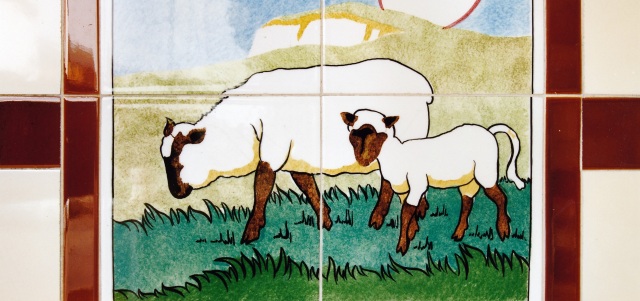
Tiles by Carters of Poole, Dewhurst, Freshwater, Isle of Wight (c. Historic England Archive AA011562)
The importation of meat from North America to Britain started in the 1860s and accelerated in the 1870s as refrigeration improved. One of the leading shippers was Timothy C. Eastman (1821-93) who owned a huge abattoir, or ‘killing yard’, in New York. From around 1875 he exported large quantities of ‘dead’ (that is, frozen) American beef to England. He was joined in his business by his son, Joseph.
The Eastmans’ Scottish agents, from 1877, were the butchers John Bell & Sons of Glasgow, a firm established in 1827. Bell & Sons had earlier imported live cattle across the Atlantic but now adopted the very latest refrigeration technology for ships. Spearheading the sale of imported dead meat within Britain, the brothers Henry and James Bell set up a chain of butcher’s shops in 1879. Ten years later they controlled 330 shops which traded as The American Fresh Meat Co. or Hill & Dale Ltd. Unlike traditional butchers’ shops, these multiples did not have their own slaughter houses; there was no need, since everything was brought in from wholesalers.
The Bells’ target clientele was the working class, which benefited from the availability of cheap foreign meat. In June 1889 they set up Eastmans Ltd., with Lord Greville as Chairman. This new venture incorporated Timothy and Joseph Eastmans’ company, and appropriated their name. In 1900, however, with interest in other markets – primarily Argentina and Australia for beef and New Zealand for lamb – growing (and America becoming correspondingly less competitive), Eastmans Ltd. liquidated the American company. It relied, thenceforth, on English wholesalers.

Eastmans, Abergavenny
In 1903 Eastmans Ltd. had 205 retail shops and cold stores capable of holding 310,000 carcasses of mutton; by 1912 the number of shops had risen to 1,400. The five years preceding the Great War, however, were lean years for the imported meat trade, due to rising prices and slack demand. For Eastmans Ltd., the war proved disastrous. Between 1914 and 1917, 495 shops closed. Most of the employees joined the forces, supplies were disrupted, and turnover was greatly reduced. In August 1920, while Eastmans was recovering from this setback, the Vestey Brothers, owners of the Union Cold Storage Co., stepped in and bought the company.
The Union Cold Storage Co. had been founded in 1897 and established the Blue Star Line in 1911. By 1923 it had 51 cold stores and freezing works abroad and at home, and a large fleet of refrigerated vessels. Beef was imported from Argentina and lamb from New Zealand; Australia was another important market. In 1923 the firm acquired the British & Argentine Meat Co. Ltd. (which had been formed in March 1914 through an amalgamation of two other chains of butchers’ shops: James Nelson & Sons Ltd. [with 1,000 shops] and George Drabble’s River Plate Meat Co. [with 440 shops]). The Vesteys now controlled 2,400 ‘retail shops, depots and market stalls in this country’, as well as factories and wholesalers.
Other chains acquired by the Vesteys in 1923 included W. & R. Fletcher Ltd., the Argenta Meat Co. Ltd., and J. H. Dewhurst. A few years later they absorbed the Empire Meat Co. The Vesteys thus became the largest meat retailer in the world, with an empire governed from an office in Smithfield Market, London. Of the numerous large meat multiples that existed before the war, just the London Central Meat Co. remained independent. In addition, the butchery departments of co-operative societies all over the country did a roaring trade. The London Co-operative Society alone, in 1934, had 159 shops plus an abattoir and a ‘meat products’ factory. It had begun to import chilled, as well as frozen, meat from around the world. Like some other multiple butchers, the London Co-operative Society sold English meat alongside imports.
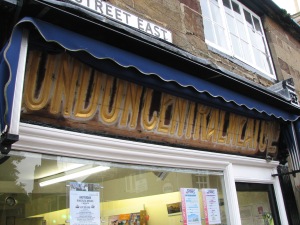
London Central Meat Co. Ltd. in Uppingham, Rutland
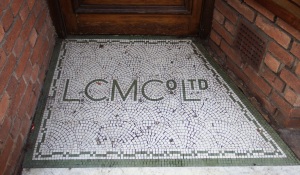
London Central Meat Co. Ltd, 3 High Street, Leominster (R. Baxter, 2017)
Ultimately, it was the Dewhurst brand (and its equivalent Alex Munro in Scotland) that came to dominate British shopping streets into the 21st century. Dewhurst’s had been founded in Southport, Lancashire, by John Henry Dewhurst whose grandfather, John Dewhurst, was a ‘master butcher’ employing a man and two boys (Census 1871).

Dewhurst, Greenwich
In the 1920s multiples like Dewhurt pioneered hygienic plate-glass frontages for butchers’ shops. Previously butchers had preferred wide sash windows that could be raised to reveal a display of meat on a marble slab. A typical example of an inter-war Dewhurst shop survives in Greenwich. The stallrisers were of pearl granite rather than wood, which might absorb water and blood.
Dewhurst made extensive use of decorative tiling. Many branches were brightened by panels depicting farmyard animals, manufactured by Carters of Poole. Around 1950, however, Dewhurst adopted chrome and plate-glass shopfronts, and established a uniform interior décor of white tiles with a black border.

Dewhurst, Macclesfield, photographed 1999
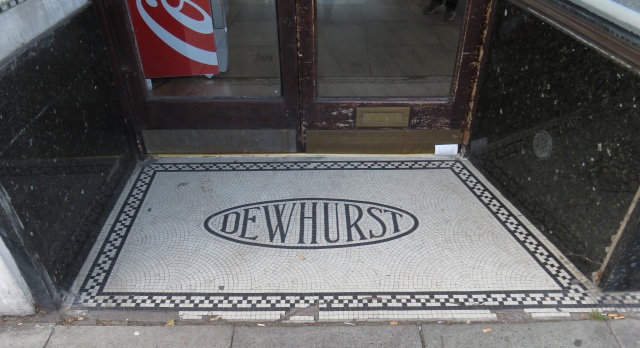
Dewhurst, Greenwich (compare with Eastmans’ floor, above)
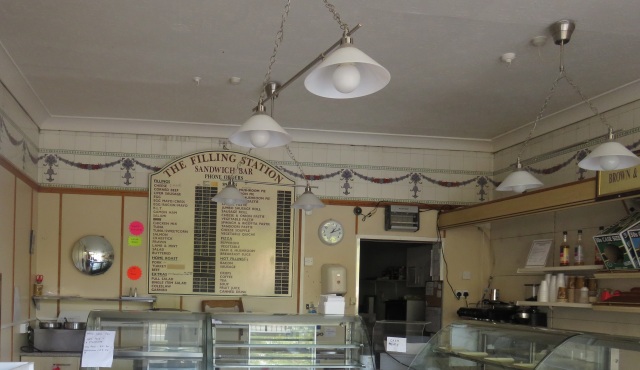
Dewhurst, Greenwich: interior showing decorative tiling
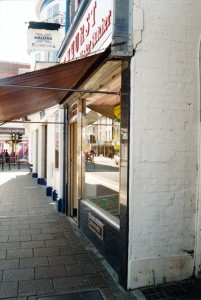
Dewhurst the Master Butcher, Newport, Isle of Wight, in 2000
In 1977 there were 1,400 Dewhurst shops in the UK, and in 1980 they were rebranded as ‘Dewhurst The Master Butcher’. There were just 360 branches, however, by March 1995, when the company went into receivership along with its holding company, Union International. A management buy-out with Asda Property Holdings rescued around 210 shops: Asda bought the freeholds and leased the shops back to Dewhurst Butchers. These were gradually updated in the early 2000s
In 2005 Dewhurst was bought by West Country butcher Lloyd Maunder. A year later Dewhurst closed 60 shops and called in the administrators to help sell the remaining 35. Like so many other meat multiples, it vanished from the British shopping scene, bowing to the superior might of the supermarkets.
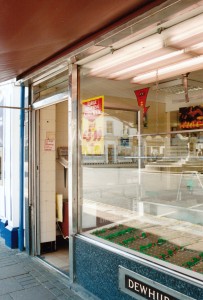
Dewhurst The Master Butcher, Newport, Isle of Wight, 2000

Very good account of the Vestey group of butchers shops, I have a number of photos on Flickr of Dewhurst my old firm, You have photos i have not got & i have 2,600, One slight error just up the page the parent company was Union International which consisted of 270 companies,
My Flickr covers the Vestey group pre 1995 as best i can, To date 5,6 million hits,
Good site of unseen photos & i thought i had seen it all, Best wishes, Norman.
LikeLiked by 1 person
Thank you so much Norman! Your photos and accompanying information on Flickr look fantastic. Prompted by your comment, I’ve done a little more research and discovered that the parent company, ‘Union Cold Storage Co Ltd’, changed its name to ‘Union International Co Ltd’ in 1949, but kept the old name (logically I suppose) for the cold storage element of the business (The Times 21 July 1949, 8). The old title, the directors said, ‘did not really indicate the company’s activities’, which I suppose was true by that point. Very best, Kathryn. PS: Have edited the name!
LikeLike
Thank you for this interesting page. I am making historical study of the Vestey ventures in China. Would you know if the company keeps any archive that it opens to researchers?
LikeLike
Thanks Thomas. I am afraid I don’t know, but I bet Norman Finnimore (see above) can advise!
LikeLike
Thank you!
My question is about a plant they built in Manchuria in 1916. I know it stayed in operation throughout the 1940s, but couldn’t imagine that they exported to uK as originally planned. Maybe to Russia, actually, but not UK.
It’s a mystery I need to solve!
LikeLike
No archive that i know of being a very secretive company, There is a coffee table size book on the Vestey group which i have only available from H/O Coulsdon Lyn Pearson FOC to me & 2 for friends, £10 P&P. each, Vestey exported eggs (dried) from China to the UK mainly for the bakery trade, Type my name into Google or Flickr, 2,700 photos 5.7 million hits, norman.finnimore@yahoo.com.
LikeLike
I believe the founder of Dewhurst’s butcher shops was a man called Cornelius Dewhurst & suspect the JH that is named here was a descendant.
in the 1980s a work colleague Cornelia (surname was her married name) who was born a Dewhurst from the southport area told me how Vestey’s had taken over her ancestor’s family business – I see on line there are ferences in baptismal records to a Cornelius Dewhurst – as a farmer and butcher.
“Marriage: 29 Jun 1887 St Paul, Southport, Lancs.
James Ourey Platt – 27, Vetinary Surgeon, Bachelor, 26 Princes Street
Jane Dewhurst – 27, Spinster, The Farm Southbank Road
Groom’s Father: James Platt, Gentleman
Bride’s Father: Cornelius Dewhurst, Farmer
Witness: Cornelius Dewhurst; Annie Dewhurst
Married by Banns by: C. H. Hatfield Curate of Christ Church
Register: Marriages 1881 – 1894, Page 102, Entry 203
Source: LDS Film 1849662”
https://www.lan-opc.org.uk/Southport/Southport-Central/stpaul/marriages_1881-1894.html
“Baptism: 30 May 1839 Christ Church, Southport, Lancs.
Cornelius Dewhurst – Son of James Dewhurst & Elizabeth
Abode: Southport
Occupation: Butcher
Baptised by: Wm. Docker Per Curate
Register: Baptisms 1824 – 1839 from the Bishops Transcripts, Page 109, Entry 1
Source: LDS Film 1068944”
https://www.lan-opc.org.uk/Southport/Southport-Central/christchurch/baptisms_1824-1839.html
LikeLike
First name(s) John Henry
Last name Dewhurst
Age 23
Birth year 1877
Marital status Bachelor
Occupation Butcher
Residence Chapel Street
Father’s first name(s) Thomas Joseph
Father’s last name Dewhurst
Father’s occupation Butcher
Year 1900
Marriage year 1900
Marriage date 25 Apr 1900
Denomination Church Of England
Place Southport, St Andrew
Diocese Liverpool
County Lancashire
LikeLike
Thanks Norman!
LikeLike
Thanks for this! Cornelius was John Henry’s great-uncle. As you say, his father James (JH’s great-grandfather) was already in the trade in the early C19th. Sounds like there was no escape for JH!
LikeLike
I used to clean te brass sign under shop widow took ages looking for b photo
LikeLike
I never saw a brass sign in my time on JHD, I had 6ft enamel Eastmans, Signs were over the window out of reach,
LikeLike
I’ve got 1879 receipts C Dewhurst, Southport. with 2 addresses. Purveyor to Her Majesty. Has pic of lamb and Coat of Arms.
LikeLike
Gosh, that’s quite early!
LikeLike